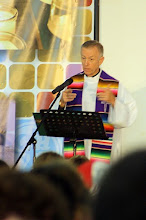
So much for the French Plus ca change...
In 1876, there was in the works a plan (seemingly backed by the ultra-conservative Cardinal Manning—himself a convert from the Church of England) to support the creation of
"...an Anglican ‘uniate’ church which would allow a married clergy, on the model of the Eastern rite churches in communion with Rome….The plan, which soon collapsed, involved accepting not only papal infallibility, but also conditional reordination; it appeared unlikely to commend itself to many Anglo-Catholics" (Ian Ker, John Henry Newman: A Biography, p. 695).
This is a fascinating view, historically speaking, in light of the developments in relationships between Anglicans/Episcopalians and Catholics in the last 30 years, from ARCIC [the Anglican-Roman Catholic International Commission], through the first “pastoral provision” of the early 1980s, to the current Apostolic Constitution. Ironically, the 2 issues that Newman thought would keep many (if any) Anglicans from embracing the idea seem not to be issues any more. The Episcopalians past and future who are married priests would in fact be (as Rev Bry Shields and Rev Leo Weisshar were) re-ordained absolutely and not conditionally. And the idea of papal authority (at least in terms of being a focal point of unity and authoritative teaching) seems to be one now eagerly sought out. So what is it that is really at issue between the Catholic Church and the Worldwide Anglican Communion?
In spite of some people’s fears that this is making things “too easy,” the direction of the Apostolic Constitution is in the direct line of the most recent popes, from John Paul II (quoted in Benedict’s greeting of Patriarch Bartholomew in a post above), and Paul VI, who said (in the context of the canonization of the English Catholic martyrs of the 16th-17th centuries): “…when the unity of faith and life is restored…there will be no seeking to lessen the legitimate prestige and usage proper to the Anglican Church…[our] ever beloved sister.”
We are on the verge of something ecumenically traumatic and triumphant—we are on the verge of something which can forge an authentic unity or cause us to shatter ‘like a potter’s vessel’ (Ps. 2:9). Which will it be? On which side will we labor? On which side will we stand in prayer and hope?
This is a fascinating view, historically speaking, in light of the developments in relationships between Anglicans/Episcopalians and Catholics in the last 30 years, from ARCIC [the Anglican-Roman Catholic International Commission], through the first “pastoral provision” of the early 1980s, to the current Apostolic Constitution. Ironically, the 2 issues that Newman thought would keep many (if any) Anglicans from embracing the idea seem not to be issues any more. The Episcopalians past and future who are married priests would in fact be (as Rev Bry Shields and Rev Leo Weisshar were) re-ordained absolutely and not conditionally. And the idea of papal authority (at least in terms of being a focal point of unity and authoritative teaching) seems to be one now eagerly sought out. So what is it that is really at issue between the Catholic Church and the Worldwide Anglican Communion?
In spite of some people’s fears that this is making things “too easy,” the direction of the Apostolic Constitution is in the direct line of the most recent popes, from John Paul II (quoted in Benedict’s greeting of Patriarch Bartholomew in a post above), and Paul VI, who said (in the context of the canonization of the English Catholic martyrs of the 16th-17th centuries): “…when the unity of faith and life is restored…there will be no seeking to lessen the legitimate prestige and usage proper to the Anglican Church…[our] ever beloved sister.”
We are on the verge of something ecumenically traumatic and triumphant—we are on the verge of something which can forge an authentic unity or cause us to shatter ‘like a potter’s vessel’ (Ps. 2:9). Which will it be? On which side will we labor? On which side will we stand in prayer and hope?
FYI: in the picture, along with Archbishop of Canterbury Rowan Williams and Pope Benedict XVI, is Cardinal Walter Kasper, head of the Secretariat for Christian Unity.

No comments:
Post a Comment